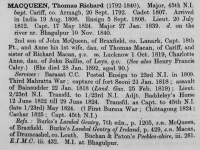Maybe somewhat late, though if still of interest, I also took a (brief) look at ...
• MacQueen's Bustard
Chlamydotis macqueenii (J. E.) GRAY 1832 (for the OD/Plate itself, see Martin's link in post #2, or
here), as "
Otis Macqueenii", a k a the Asian/Eastern Houbara (Bustard)
Psophia/
Houbara/
Eupodotis (
undulata/undulatus)
macqueenii, from the "Hamalaya [
sic] Mountains"
* (
i.e. the alleged 'type location', as given on the Plate).
This taxon was also mentioned by Blyth, in
Journal of the Asiatic Society of Bengal 16, Part 2 (1847),
here. And by R. Bowdler Sharpe (in 1894,
here), with multiple references, and synonyms.
Either way, note that Mearns & Mearns in their new
Biographies for Birdwatchers (Revised and Expanded edition,
2022) says:
... The Bustard was named by J.E. Gray in 1832 on a colour plate in his Illustrations of Indian Zoology, from a specimen found in the northern part of the Indian subcontinent. ... Its Himalayan type locality was so obviously in error, that in 1930 it was amended to “the foothills of N.W. India” (which would now include north Pakistan). 1 Gray's specific name macqueenii continues to be a mystery as no one has yet proved the identity of Macqueen (the spelling we shall use throughout to cover such variants as MacQueen, McQueen and M’Queen).
[...]
Thereafter follows a long account, of six rich (A4) pages [!], covering their multiple, both intriguing and time-consuming, efforts to find the said 'Macqueen' (dealing with, and following the trails of, various possible and/or alleged dedicatees) incl.; Dr
Kenneth Macqueen, Reverend John Macqueen, Major Thomas Richard Macqueen (who apparently was neither a General, nor a General-Major alt. a Major-General? [just like Paul stated in post #10]), as well as a Captain Simon Macqueen, a Surveyor by the name Alexander Macqueen, an MP Thomas Potter Macqueen, a pro-slavery geographer James Macqueen, an ornithology interested James Neville Macqueen, etc., etc.), with several analyses, incl. pros and cons, with their points of favour/s, and dittos against, all in all trying to sort out their respective advantages and disadvantages, with arguments and considerations, for and against, back and forth, ... ending up with nothing but an anonymous Mr Macqueen:
[...]
After all this rummaging and rather too much speculation, we are forced to re-quote Gladstone: “to be judicially fair it cannot be said that the Macqueen who gave his name to Macqueen’s Bustard has been identified.” The answer, if there is one, may yet lie hidden amongst Hardwicke’s voluminous papers.
Footnote 1 (in the first quote above):
Ticehurst, C. B. 1930. Notes on the Fauna of British India; Birds. Vol 4, 5 & 6. Journal of the Bombay Natural History Society 34: 468-490 [i.e. page 482, here]
And their reference/s to "Gladstone" is/are:
Gladstone, H [Hugh]. 1948. Macqueen’s Bustard. Ibis 90 [No. 2]: 337–338. [unseen by me]
Gladstone, H. 1948. Macqueen’s Bustard. Claims of those of the name Macqueen who may have given their names to the bird. Unpublished typescript, dated 18 May 1948. [ditto]
All in all, I do agree with the Mearns Couple, as I doubt that a, or any, Doctor (or Surgeon) or even an Officer of the British (Imperial) Army, would have been called just "Mr MacQueen", not in that Era. In those days most people was pretty careful (even meticulous) concerning their respective proper/correct Titles.
["Farnboro John", as I've never seen this assertion/statement before, please develop your claims, as told in post #8, preferably also with examples (in earlier threads/topics we've seen many, many surgeons titled "Dr."). Also see, for another example, from 1831:
here].
Thus, this far (at least to me) Mr MacQueen does remain a mystery.
If anyone feel like having yet another go, the many Papers left by Hardwicke [Thomas Hardwicke (1756-1835)
**], seems to be kept in the British Museum, and in the British Library (see
here).
And, if giving it a try: Good luck!
Björn
PS. I´m pretty glad he isn't one "of my guys", as this Bird is called
kragtrap in Swedish (meaning Collared Bustard, a name far, far easier to understand, and explain)

PPS. As well note that Hardwicke's Plates was done by ('his') hired, local Indian Artists,
not by Hardwicke himself, which has often been claimed, in various texts (and all over the internet).
* "Hamalaya" (Mountains) might/could possibly[?] also indicate an Origin from the North-Eastern parts of today's Afghanistan. Or not?
** Hardwicke himself was also commemorated in several Birds (according to the Key here).





